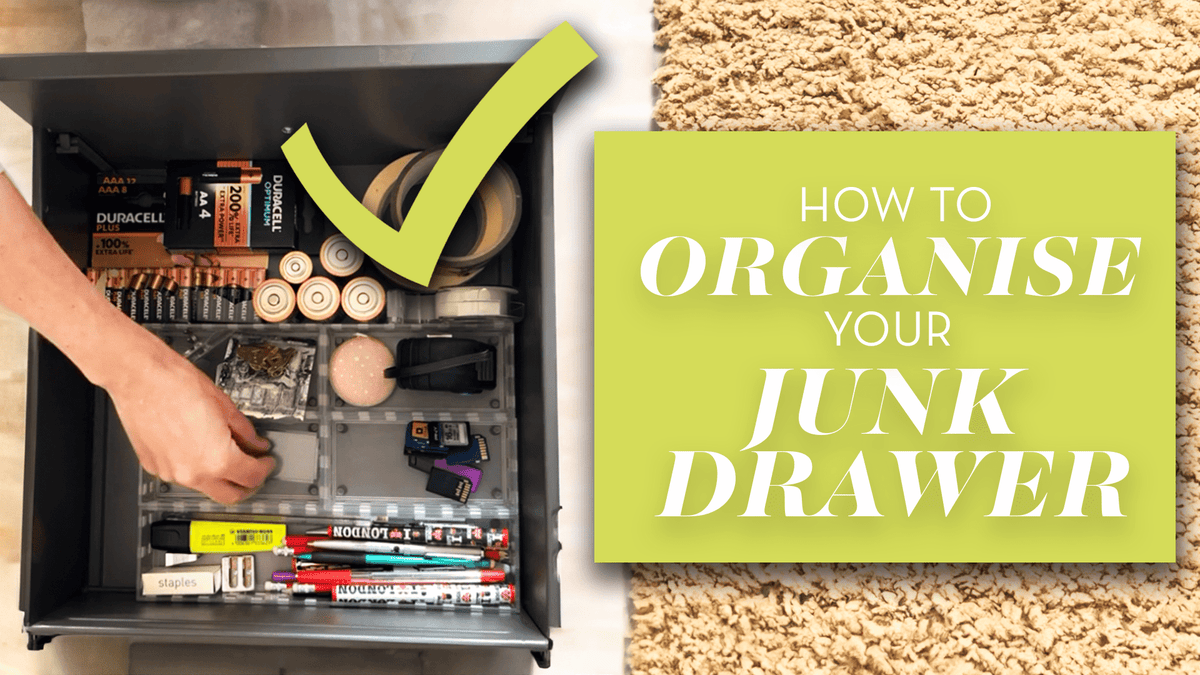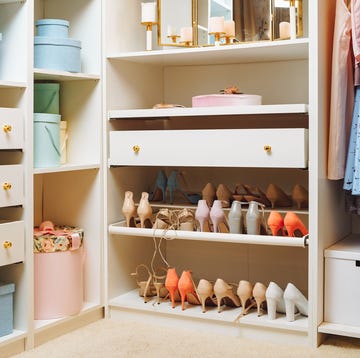There’s no right way to declutter, but there are common mistakes we can make. Whether you find yourself lost down memory lane, or taking on too much at once, these habits can slow down the task. You end up feeling defeated and unable to finish what you started.
One such habit is ‘churning’ – and no, it’s nothing to do with butter! Churning is a mindset that can get in your way when you’re making those crucial decisions over what to keep and what to declutter. But what is it exactly and how can you stop it? We asked the experts to weigh in.
What is churning?
Churning is more commonplace than you’d think. It’s the act of moving things around as you declutter but failing to make a final decision on them. It’s that ‘save for later’ pile, which never gets addressed and gradually ends up working its way back into your cupboards.
“Churning occurs when you set out to declutter but instead of reducing surplus stuff in your home, you simply move it from one place to another,” says Juliet Landau-Pope, productivity coach and author of What’s Your Excuse For Not Clearing Your Clutter? “This can be due to emotional overload and a deluge of decisions, leading to uncertainty about letting go.
“For example, you start organising paperwork on your desk and come across a batch of old receipts but then you’re struck by uncertainty over what to do next. Do you need to keep them all or just some of them? Where should they be filed? Or can they be shredded? But do you need to delete personal data first? Overwhelmed by decisions, you opt for inaction, moving them from the desk to a sideboard ‘just for now’.”
As Good Housekeeping's household advice editor, I do a lot of decluttering, but I'm also not immune to churning. Recently, I filled a couple of bin bags with clothes from my wardrobe declutter, giving myself a temporary sense of relief and accomplishment, and then left them tucked away in the corner of the front room. I knew the items needed removing, one way or another, but I couldn’t bring myself to let them go. The effort required to sell items that were worth some money deterred me, and for those that needed donating, I kept second-guessing my decisions.
In the end I had to go through what I’d decluttered again, just to remind myself what was in the bags, and then set myself a deadline for when the items needed to be removed by, whether they needed donating, selling, or recycling.
Is churning really a problem?
At first, churning doesn’t sound like a big deal, but it can have real ramifications on your decluttering efforts and result in more stress than when you started.
“Churning creates unnecessary stress and prevents true decluttering,” explains Emma Kenwrick-Meehan, professional organiser and home stylist from Home Nip and Tuck. “It leads to mental fatigue, as handling the same items repeatedly drains energy and focus. It gives a false sense of progress, making it feel like you’re organising when, in reality, the clutter remains. [And] it reinforces indecision, which can cause emotional overwhelm and make decluttering feel impossible.”
Who's likely to struggle with churning?
Everyone declutters in their own way, with a range of favourite decluttering methods out there. But, some personality types will struggle more with churning.
“Sentimental declutterers often struggle because they attach deep emotional value to their belongings,” says Kenwrick-Meehan. “Busy individuals may find it difficult to make decisions about clutter due to a lack of time and mental energy. [And] perfectionists can become stuck in the process, waiting for the “perfect” solution before letting go of something.”
“People affected by ADHD or other forms of executive dysfunction may be prone to churning due to difficulties with maintaining focus and poor working memory,” adds Landau-Pope. “Churning is often associated with chronic disorganisation. We all struggle at times with too much stuff in our homes or too much on our to-do lists, but chronic disorganisation relates to a long-term challenge, often dating back many years and impacting various aspects of life. Repeated attempts – and failure – to shift habits can undermine confidence and self-esteem, making it even harder to change behaviours. For people affected by hoarding disorder, now recognised as a complex mental health condition, these issues are particularly acute.”
How to stop churning
The first step to stop churning is being aware of the habit. Think back to when you’ve decluttered previously and if you’ve struggled with it before. Ask yourself what the result was; how long was needed to finally get rid of the items or did you get rid of them at all?
Before you start, Landau-Pope advises: “Set positive and purposeful goals that matter to you, not anyone else. Make a clear plan with criteria to help you make decisions.
“[Think about] how and where will you organise the things that you choose to keep. For example, what kind of filing system works best for you? Or do you want to hang up or fold your T-shirts? Establish exit strategies in advance – how will you recycle or donate your unwanted belongings?”
By doing this, you can set up a system in advance. So if you’re decluttering a large space, you can pencil in repeated trips to the charity shop, or set aside time to list items on eBay. This saves large piles of items gathering around the home, despite your best intentions.
“It’s important to recognise the pattern—if an item keeps resurfacing, ask yourself why you haven’t made a final decision about it,” says Kenwrick-Meehan. “Using a “one-touch rule” can help; each time you handle an item, make a firm choice about its future. Instead of shifting things around, be decisive and commit to keeping, donating, or discarding each item.
“Decluttering by category instead of by location can help prevent items from simply being moved to another area instead of being removed altogether. Asking tough questions such as ‘Would I buy this again today?’ can help clarify whether an item is truly worth keeping. [And] seeking accountability from a friend, family member, or professional organiser can provide motivation and support in making final decisions.”
Making a final decision can be tricky, particularly where the item holds some sentimental value, but the more you practice, the easier it will be and the less likely you will ‘churn’. There are professionals readily available to help if needed via the APDO (Association of Professional Declutterers and Organisers).
If you find you’re struggling with habits like churning, you can adjust your perspective by asking the right questions, such as “Did I even know or care about this item before?”, “When was the last time I used it?”, “Would someone else value it more?’ These types of questions can all help with decision-making and letting things go.






















